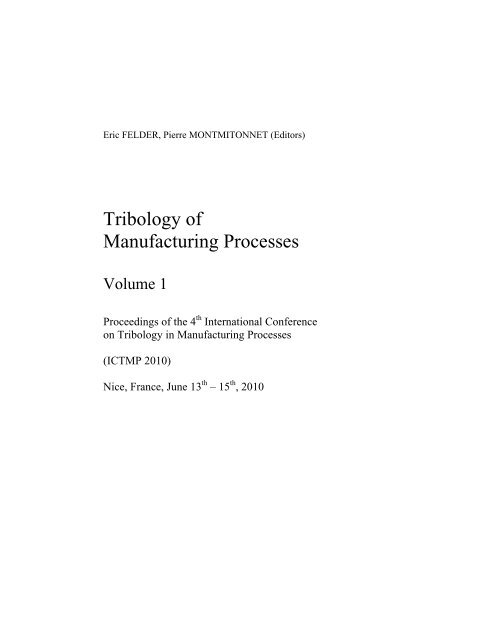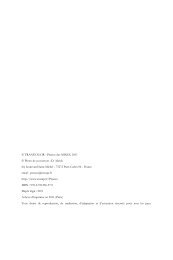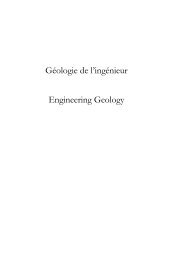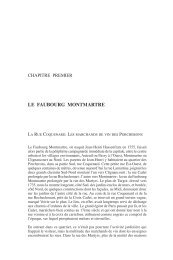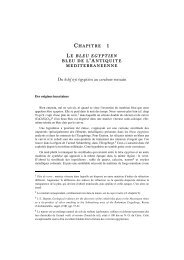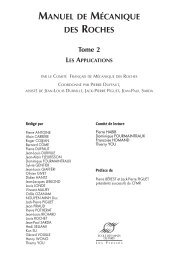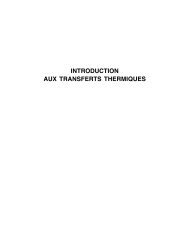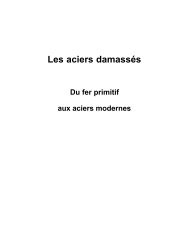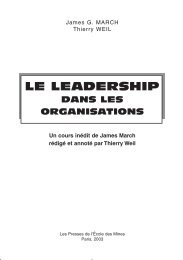Tribology of Manufacturing Processes - Presses des Mines
Tribology of Manufacturing Processes - Presses des Mines
Tribology of Manufacturing Processes - Presses des Mines
You also want an ePaper? Increase the reach of your titles
YUMPU automatically turns print PDFs into web optimized ePapers that Google loves.
Eric FELDER, Pierre MONTMITONNET (Editors)<strong>Tribology</strong> <strong>of</strong><strong>Manufacturing</strong> <strong>Processes</strong>Volume 1Proceedings <strong>of</strong> the 4 th International Conferenceon <strong>Tribology</strong> in <strong>Manufacturing</strong> <strong>Processes</strong>(ICTMP 2010)Nice, France, June 13 th – 15 th , 2010
ICTMP 2010 International Programme CommitteAkira AzushimaDorel BanabicNiels BayJean-Claude BoyerStefania BruschiKuniaki DohdaLaurent DubarUlf EngelPeter GrocheKenneth HolmbergYong Taek ImSaid JahanmirJack JeswietKazuhiko KitamuraMichał KrzyzanowskiJian LuTakashi MatsumuraFabrizio MicariTamotsu NakamuraGracious NgaileR.K. PandeyFarhad RezaiSteven R. SchmidStanislaw StupkiewiczAhn Khet TieuYoshinari TsuchiyaJože Vizintin(Yokohama National University, Japan)(Technical University <strong>of</strong> Cluj-Napoca, Romania)(Technical University <strong>of</strong> Denmark)(INSA de Lyon, France)(University <strong>of</strong> Trenta, Italy)(Nagoya Institute <strong>of</strong> Technology, Japan)(University <strong>of</strong> Valenciennes, France)Univity <strong>of</strong> Erlangen, Germany)(Technical University Darmstadt, Germany)(VTT, Finland)(KAIST, Korea)(Mohawk Innovative Technologies Ltd, USA)(Queens University, Canada)(Nagoya Institute Technology, Japan)(University <strong>of</strong> Sheffield, United Kingdom)(Hong Kong Polytechnic University, China)(Tokyo Denki University, Japan)(University <strong>of</strong> Palermo, Italy)(Shizuoka University, Japan)(North Carolina State University, USA)(Indian Institute <strong>of</strong> Technology Delhi, India)(Ecole <strong>des</strong> <strong>Mines</strong> d’Albi-Carmaux, France)(University <strong>of</strong> Notre-Dame, USA)(IFTR, Poland)(University <strong>of</strong> Wollongong, Australia)(Toyota Central R&D laboratories, Japan)(University <strong>of</strong> Ljubljana, Slovenia)ICTMP 2010 International Scientific CommitteeKuniaki Dohda,William R.D. WilsonNiels BayAkira AzushimaSaid Jahanmir(Nagoya Institute <strong>of</strong> Technology, Japan)(University <strong>of</strong> Washington, Seattle, USA)( Technical University <strong>of</strong> Denmark, Lyngby, Denmark)(Yokohama National University , Japan)(MiTiHeart Corporation, Gaithersburg, USA)ICTMP 2010 Local Organizing Committee(MINES-ParisTech, Sophia-Antipolis, France)Patrick CoelsLaurent GatratPierre MontmitonnetEric FelderHanitra LaiarinandrasanaFlorence Morcamp
LIST OF CONTENT - VOLUME 1Preface 1P. MONTMITONNET, E. FELDERPlenary LecturesGreen Lubricants for metal forming 5N. BAY, T. NAKAMURA, S. SCHMIDLubricantsEffect <strong>of</strong> extreme-pressure additives in milling <strong>of</strong> high-strenth steels: mechanical andphysico-chemical approaches 37A. BIERLA, G. FROMENTIN, C. MINFRAY, J.-M. MARTIN, T. LE MOGNE, N.GENETEvaluation <strong>of</strong> Environmentally Friendly Lubricants for Cold Forging 51T. NAKAMURA, I. ISHIBASHIEvaluation <strong>of</strong> Lubricant Carrier Coatings for Bulk Metal Forming <strong>of</strong> Steel at ElevatedTemperatures using Double-Cup-Extrusion-Test 61C. MLETZKO, M. LIEWALD, A. FELDEEvaluation <strong>of</strong> Anti-galling Property <strong>of</strong> Forming Oil for Stainless Steel by Cup InternalIroning Test 71K. KITAMURA, M. MAKI, M. KASTURAGAWA, S. YAMAMOTO, T. MURAOTribological performance evaluation <strong>of</strong> Cold Pilgering lubricants 81J. HARDELL, B. PRAKASHCutting and MachiningA thermo-mechanical model <strong>of</strong> friction phenomena in machining: analysis <strong>of</strong> the slidingstickingzones at the tool-chip interface 97S. BAHI, M. NOUARI, A. MOUFKI, M. EL MANSORI, A. MOLINARIExperimental characterization <strong>of</strong> friction coefficients at the tool-chip-workpieceinterface dry cutting <strong>of</strong> an AISI 1045 111H. BEN ABDELALI, C. CLAUDIN, J. RECH , W. BEN SALEM, P. KAPSA, A.DOGUIIdentification <strong>of</strong> limiting shear stress at tool-chip interface Towards an improved FEmodel<strong>of</strong> Titanium alloy (Ti-6Al-4V) cutting 121Y.C. ZHANG, T. MABROUKI, D. NELIAS, Y.D. GONG
Influence <strong>of</strong> tool wear and process parameters on workpiece strain hardening 131G. D’URSO, A. ATTANASIOAnalytical model <strong>of</strong> removal material in the case <strong>of</strong> cutting and abrasion processesF. SALVATORE, T. MABROUKI, H. HAMDI 141A study <strong>of</strong> friction conditions in Ti6Al4V drilling 151C. BONNET, G. POULACHON, J. RECH, Y. GIRARDTowards a better definition <strong>of</strong> the mechanical and thermal interface behaviour in drycutting simulation <strong>of</strong> AISI 1045 steel 161C. COURBON , T. MABROUKI , J. RECH, J.-F. RIGAL, D. MAZUYER, E.D’ERAMO., P. DAGUIERTool wear influence on white and dark layer in hard steel turning 171A. ATTANASIO, C. CAPPELLINI, S. CARUSO, G. ROTELLA, D. UMBRELLO, R.M’SAOUBIA Methodology to estimate the forces on the tool insert in finish hard turning 181G. BARTARYA, S.K. CHOUDHURYEvaluation <strong>of</strong> cutting tool wear during lathe dry turning process from accelerometer dataR. SERRA, W. RMILI, A. OUAHABI 193A FE-approach on the influence <strong>of</strong> material strengthening factors on size effect duringmacro- to micro-scale milling 203M. ASAD, T. MABROUKI, J.-F. RIGALSurface treatments and finishing processes, coatingsTribological effects <strong>of</strong> shot peening, laser peening and Case process 215E. DANIELImproving tribological behavior <strong>of</strong> copper alloys using a new ion beam implantationprocess 221M. CAVELLIER, P. SALOU, D. BUSARDO, T. GLORIANTMicro dimpled surface by Ultrasonic Nanocrystal Surface Modification and itstribological effects 229A. AMANOV, Y.-S. PYOUN, I.-S. CHO, C.-S. LEE, I.-G. PARKEffect <strong>of</strong> Shot Peening on Surface Texture 239Y. KOBAYASHI, K. TOSHA, S. SHIMIZUApplication <strong>of</strong> hard coatings for blanking and piercing tools 249B. PODGORNIK, B. ZAJEC, N. BAY, J. VIŽINTINImpact <strong>of</strong> coating systems on the tribological and wear behavior <strong>of</strong> hot stamping toolM. WIELAND, M. MERKLEIN 261
Wear Tests for Stamping Dies via Slider Type <strong>of</strong> Test System 271Ö.N. CORA, K. NAMIKI, M. KOÇWear reduction <strong>of</strong> fine blanking tools by high performance PVD tool coating andadapted substrate preparation 281F. KLOCKE, H. WEGNER, P. MATTFELD, M. ZIMMERMANN, K. BOBZIN, N.BAGCIVAN, M. EWERING, R. BRUGNARAEvaluation <strong>of</strong> Tribo-characteristics <strong>of</strong> DLC-Si by Metal Forming Simulators 293K. DOHDA, Y. TSUCHIYA, K. KITAMURA, H. MORIQualification <strong>of</strong> a new test for wear investigation on coated tools 303T. SCHRADER, M. MERKLEIN, U. ENGELEffect <strong>of</strong> tool coatings on friction behavior during hot aluminum extrusion 313A. SEGATORI, N. BEN KHALIFA, A. JÄGER, L. DONATI, L. TOMESANI, A. E.TEKKAYATribological behaviors <strong>of</strong> carbon-carbon composites prepared by chemical liquid-vaporinfiltration 325K.-Z. LI, H.-L. DENG, H.-J. LI, P.-Y. WANGThe Multi-Scale Analyses <strong>of</strong> the Grit Size Effect <strong>of</strong> Ground Surfaces 335M. BIGERELLE, T. MATHIA, S. BOUVIERNew effective and precision polishing method with water-based slurry, controlled by ACelectric field during processing 347H. IKEDA, Y. AKAGAMI, T. KUSUMI,Y. SATO, T. K. DOIEfficient fabrication process <strong>of</strong> optical functional surfaces by using nano-plastic formingM. YOSHINO, R. OKABE, H. OHSAWA, A. YAMANAKA, T MATSUMURA 355Rapid fabrication <strong>of</strong> functional surface using the combination <strong>of</strong> Nano-Plastic Forming,coating, and roller imprinting process 365W. KURNIA, M. YOSHINOControl <strong>of</strong> Wettability with Micro-scale Structure on Functional Surface 375T. MATSUMURA, T. HIROSE, M. YOSHINO, N. UMEHARAForging and wire-drawingExperimental validation <strong>of</strong> the plastic wave approach in hot forging <strong>of</strong> steels 385L. VIGNERON, E. VIDAL-SALLE, J.C. BOYER, M. DUBAR, L. DUBARCrystal Plasticity Finite Element Modelling <strong>of</strong> Surface Asperity Flattening duringUniaxial Planar Compression 397H.J. LI, Z.Y. JIANG, D.B. WEI, P.J. YAN, J.T. HAN, A.K. TIEUCoefficient <strong>of</strong> Friction at the Interface <strong>of</strong> Lubricated Upsetting Process 407A. AZUSHIMA, S. YONEYAMA, H. UTSUNOMIYA
Identification <strong>of</strong> the work <strong>of</strong> plastic deformation and the friction shear stress in wiredrawing 417E. FELDER, C. LEVRAU, M. MANTEL, N.G. TRUONG DINHQuantification <strong>of</strong> lubricant film thickness by a fluorescence measurement techniqueC. MUELLER, M. LUDWIG, P. GROCHE 427Experimental study <strong>of</strong> the dry lubrication by soaps in stainless steel wire drawing 435E. FELDER, C. LEVRAU, M. MANTEL, N.G. TRUONG DINHContact Mechanics <strong>of</strong> a wire on a conical surface 445M. DERDEYN, H. VAN HOECKERecent Developments in Ironing with Polymer-Coated Steels 455M.A. SELLÉS, T. BORONAT, S.R. SCHMIDAuthors’ IndexLIST OF CONTENT - VOLUME 2Forging and wire-drawing (continued)Influence <strong>of</strong> Ultrasonic Vibration on Microextrusion and Analytical Model forPredicting Temperature Generation 467A. GHOSH, G. NGAILEThermohydrodynamic Analysis <strong>of</strong> Inlet Zone for Minimum Film Thickness inHydrostatic Cold Extrusion Process 477P. TOMAR, P. SINGH, R. K. PANDEY, Y. NATHDesign <strong>of</strong> a direct extrusion process for the identification <strong>of</strong> the tribological properties <strong>of</strong>metallic materials used in cold forming 487A. GAVRUS, D. T. PHAM, H. FRANCILLETTEDirect testing <strong>of</strong> scale effects in metal forming friction and lubrication 497P.S. NIELSEN, N.A. PALDAN, M. CALAON, N. BAYFriction measurement by the tip test for cold forging 507Y.-T. IM, K-H JUNG, H.-C. LEE, D.-K. KIM, S.-H. KANGStudy <strong>of</strong> Influence <strong>of</strong> Friction and Angle <strong>of</strong> Curvature in ECAE 517K. HANS RAJ, R. SWARUP SHARMA, R. SETIA, S. SWARUP SHARMAMechanical analysis <strong>of</strong> the gold leaves beating 529E. FELDERTailored Surfaces in Sheet-Bulk Metal Forming 541H.U. VIERZIGMANN, M. MERKLEIN, U. ENGELTribological Aspects in Electrically-Assisted Forming 551C. BUNGET, W. A. SALANDRO, L. MEARS
Sheet Metal FormingMechanical analysis <strong>of</strong> the contact between the sheet and the blankholder in deepdrawing 563E. FELDER, G. PAYENMultiscale Friction Modelling in Sheet Metal Forming 573J. HOL, M.V. CID ALFARO, M.B. DE ROOIJ, T. MEINDERSEffect <strong>of</strong> size and velocity dependent friction in deep drawing on the process window 583Z.Y. HU, F. VOLLERTSENPlastic Deformation in Surface Layer <strong>of</strong> Metal Foil in Strip Drawing Test 593T. SHIMIZU, K.-I. MANABE, M. YANG, K. ITOThe Influence <strong>of</strong> Grinding and Polishing Procedure <strong>of</strong> Tool Steels in Sheet MetalForming 603F. LINDVALL, J. BERGSTRÖM, P. KRAKHMALEV, N. BAYFriction in sheet metal forming - A comparison between machined and manuallypolished die surfaces 613D. WIKLUND, M. LILJENGREN, J. BERGLUND, N. BAY, K. KJELLSSON, B-G. ROSÉNStudy <strong>of</strong> surface friction in Single-Point Incremental Forming 623K. HAMILTON, J. JESWIETSome considerations on friction in incremental sheet forming processes 633G. AMBROGIO , G. L. MANCO AND L. FILICEIncremental sheet metal forming simulation using adaptive remeshing 643L. GIRAUD-MOREAU, J. ZHANG, A. CHEROUAT, H. BOROUCHAKIBasic principles and associated mechanisms <strong>of</strong> electromagnetic pulse welding 651A. ELSEN, M. LUDWIG, R. SCHÄFER, P. GROCHETube Hydr<strong>of</strong>orming Friction estimation through thickness measurement – A numericalstudy 663A. FIORENTINO, E. CERETTI, R. MARZI, C. GIARDINIGalling resistance and wear mechanisms for cold work tool steels in lubricated slidingagainst high strength stainless steel sheets 673P. KARLSSON, A. GÅÅRD, P. KRAKHMALEV, J. BERGSTRÖMDevelopment <strong>of</strong> a segmented hydro-elastic blank holder for deep drawing 683B.A. BEHRENS, S. HÜBNER, C.P. ECKOLD, P. GROCHE, M. ERTUGRULDeep drawability <strong>of</strong> DLC-coated A5052 Aluminum alloy sheet 691T. HORIUCHI , S. YOSHIHARA, Y. IRIYAMATribological study <strong>of</strong> a press-fit assembling process 701L. BOISSONNET, B. DUFFAU, P. MONTMITONNET
Abrasive wear <strong>of</strong> boron-added high-chromium white irons 711A. BEDOLLA-JACUINDE, R. CORREA, I. MEJÍA, J. ZUNO-SILVA, J. VERDUZCOInfluence <strong>of</strong> texturing on corrosion resistance <strong>of</strong> galvanized steel sheet after forming processE. ABBASI, M. SABOONI, M.R. SALMANI 723Strip RollingFlexible lubrication concept, the future <strong>of</strong> cold rolling lubrication 735M. LAUGIER, M. TORNICELLI, C. SILVY-LELIGOIS, D. BOUQUEGNEAU, D. LAUNET,J.A. ALVAREZMechanism and Improvement <strong>of</strong> Scratch Marks in Cold Rolling <strong>of</strong> Thin Strip 745X.Z. DU, Z.Y. JIANG, Z.H. BAI, A.K. TIEUImproving strip Cleanliness after Cold Rolling 753L. JACOBS, B. VERVAET, H. HERMANN, M. AGOSTINI, J. KURZYNSKI, N-G. JONSSON,J. PEREZ, K. REUVER, H. VAN STEDENBack-calculation <strong>of</strong> friction during cold rolling <strong>of</strong> stainless steels and its influence onsurface quality 769H. VANDEKINDEREN, L. DUBAR, R. DELTOMBE, J.M. DAMASSEIncidence <strong>of</strong> friction on heat generation in cold rolling <strong>of</strong> aluminium 779P. DENEUVILLEEnhanced mixed lubrication model for cold rolling based on a modular and hierarchicalstructure 789M. BERGMANN, K. ZEMAN, A. KAINZ, K. KRIMPELSTÄTTER, D. PAESOLDMETALUB : A slab method s<strong>of</strong>tware for the numerical simulation <strong>of</strong> mixed lubricationregime. Application to cold rolling. 799Y. CARRETTA , A. STEPHANY , N. LEGRAND,M. LAUGIER, J.P. PONTHOTLocal approach strategy to the roughness prediction <strong>of</strong> stainless steel strip 809R. DELTOMBE, A. BELOTSERKOVETS, M. DUBAR, A. DUBOIS, L. DUBARPlate-out modeling for cold rolling system lubricated with O/W emulsion 819R. GUILLAUMENT, S. VINCENT, J. DUCLOS, M. LAUGIER, P. GARDINNew Concept <strong>of</strong> Friction Sensor for Strip Rolling - Theoretical Analysis 831N. LEGRAND , T. LAVALARD, A. MARTINSA surface transducer for roll gap measurements <strong>of</strong> friction and load in both hot and coldrolling 845N.-G. JONSSON, J. LAGERGREN, T. WANHEIMContact pressures and frictional forces in the roll gap during symmetric and asymmetrichot rolling 859A. NILSSON, N.-G. JONSSONA study on tribological behavior <strong>of</strong> a hot work roll on a coupled mini-mill and GleebleSystem 869Q. ZHU, H.-T. ZHU, A.K. TIEU, R. DE JONG
The Tool / Workpiece interface during hot rolling <strong>of</strong> aluminium: understanding andpredictions 877M. KRZYZANOWSKI, W.M. RAINFORTHEffect <strong>of</strong> oxide scale on the friction condition and surface roughness transfer during hotrolling <strong>of</strong> 304L steels 887D.-B. WEI, J.-X. HUANG, A.-W. ZHANG, Z.-Y. JIANG, A.K. TIEU, X. SHI, S.-H. JIAODeveloping environmentally-friendly rolling lubricants 897A. JOHNSSON, M. EKMAN, A. JANOLSTribological behaviour <strong>of</strong> work roll materials in cold strip rolling 907H.-C. LI, Z.-Y. JIANG, A.K. TIEU, W.-H. SUN, D.-B. WEIAuthors’ Index
PrefaceAs in the first edition in 1997 in Gifu, Japan, the second one in Nyborg, Denmark, in2004 and the third in 2007 in Yokohama, Japan, ICTMP 2010 ambition is to gather theinternational community involved in the tribology <strong>of</strong> manufacturing processes, fromacademia as well as from industry. Apart from the everlasting trend towards moreefficiency and productivity associated with lower costs, recent years have witnessed theemergence <strong>of</strong> new orientations, such as micr<strong>of</strong>orming for microsystems and MEMS, ormicro- to nano-patterning <strong>of</strong> surfaces for improved tribological properties or moregenerally for surface functionalization ; both raise new questions <strong>of</strong> scale effects onfriction. Environmental concerns bring to the forefront the need for new, “greenerlubricants”, or for using less lubricant (Minimal Quantity Lubrication, or MQL) forexample with the help <strong>of</strong> improved coatings. New coatings from non-toxic and easilydisposable baths, or new coating deposition or surface hardening and texturingtechniques, are also central in the industrial evolutions. From another point <strong>of</strong> view,friction measurement and friction models are more and more requested to account for itsspace- and time-dependence, both in view <strong>of</strong> the local or time-varying control <strong>of</strong> frictionin the shop, and in the modelling <strong>of</strong> processes.All these trends are both new constraints imposed on the mechanical engineer, andsources <strong>of</strong> new thrilling research topics for his advisor, the Tribologist, as will becomeobvious at reading the following research reports. The present two volumes present awelcome review <strong>of</strong> advances in the tribological practice and knowledge <strong>of</strong> suchtraditional processes as deep-drawing and stamping, hot and cold forging, wire-drawing,strip rolling, or assembling processes, cutting and machining, while giving an insightinto newer or less vulgarized forming, assembling or finishing techniques.The Organizing Committee heartily thanks the authors <strong>of</strong> the 88 contributions to thisConference and to the present Proceedings, and specially the Programme Committeewhose members worked hard to review the papers and improve their quality.Eric FELDER, Pierre MONTMITONNETChairmen, ICTMP 20101
PLENARY LECTURE
GREEN LUBRICANTS FOR METAL FORMINGNIELS BAY 1 , TAMOTSU NAKAMURA 2 STEVEN SCHMID 3 ,1TECHN. UNIV. OF DENMARK, Dept. <strong>of</strong> Mech. Engn., Produktionstorvet 425,dk 2800 Kgs. Lyngby - Denmark2 SHIZUOKA UNIV., Dept. <strong>of</strong> Mech. Engn., 3-5-1, Naka-ku, Hamamatsu, 432-8561- Japan3 UNIV. NOTRE DAME, Dept. Aerosp. & Mech. Engn. 150 Multidiscipl. Res. Bldg.Notre Dame, IN 46556 - USAAbstractThe increasing focus on legislation towards diminishing the impact on workingenvironment as well as external environment has driven efforts to develop new,environmentally benign lubricants for metal forming. The present paper gives anoverview <strong>of</strong> these efforts to substitute environmentally hazardous lubricants in cold,warm and hot forging as well as sheet forming and punching/blanking with new, lessharmful lubricants.Keywords: metal forming tribology, lubricants, environmental impact1 INTRODUCTIONSince 2000, legislation in Europe, Japan and USA has been increasingly restrictive withrespect to the industrial application <strong>of</strong> hazardous lubricants, [1- [4]. Due to theselegislative initiatives, manufacturers are increasingly focused on environmental concernsand request their suppliers to act proactively to establish safe and healthy workingconditions while limiting the strain on the environment.Environmental problems in metal forming tribology, can be divided into the followingareas, [5]: a) health and safety <strong>of</strong> people, b) influence on equipment and buildings, c)<strong>des</strong>truction and/or disposal <strong>of</strong> waste and remaining products. Improvement efforts areconcentrated on 1) elimination <strong>of</strong> hazardous chemicals, e.g. chlorinated additives orphosphates with (heavy) metal sludge, and 2) reduction <strong>of</strong> waste, including prolongingtool and lubricant life, recovery and reuse <strong>of</strong> lubricants and Minimal QuantityLubrication (MQL).Due to the very varied tribological conditions in different metal forming processes thelubricants applied are quite different in different production processes. The presentpaper gives an overview <strong>of</strong> the environmental problems regarding traditionally appliedlubricants and the development and testing <strong>of</strong> new, environmentally benign lubricantsfor cold forging, warm/hot forging, rolling, sheet metal forming and punching/blanking.2 COLD FORGINGDevelopment <strong>of</strong> the cold forging process <strong>of</strong> steel and its successful application in theautomotive industry since 1960 is closely connected to the development <strong>of</strong> efficientlubrication systems consisting <strong>of</strong> a conversion coating <strong>of</strong> zinc phosphate chemically5
4 th International Conference on <strong>Tribology</strong> in <strong>Manufacturing</strong> <strong>Processes</strong> - ICTMP 2010bonded to the metal substrate. The coated part is provided with a lubricant by dippinginto a hot bath <strong>of</strong> alkaline soap (typically sodium stearate) that reacts with the zincphosphate to form zinc stearate, which is eventually covered with excessive sodium soap[6,7]. The crystalline layer <strong>of</strong> zinc phosphate partly acts as a chemical agent binding thesoap to the surface, and partly as physical carrier for the soap. The coating procedurehas several environmental drawbacks [8-[13]: a) Sludge <strong>of</strong> (heavy) metal phosphates,which need to be reclaimed or buried, b) Large water requirement in the rinse baths, c)Periodic replacement <strong>of</strong> baths for degreasing, neutralizing, pickling and lubricationrequired, d) Large amounts <strong>of</strong> waste water, typically containing grease and tramp oils,acid, and soap. In addition to these environmental concerns, the phosphating processrequires prolonged treatment time, typically 5-15 min. and high bath temperature, 80-90˚C, [6,9].Zwez and Holz [14] report that modification <strong>of</strong> zinc phosphate coatings with calciumreduces the load <strong>of</strong> heavy metal zinc by 33% thus reducing the impact on environment.Within this conventional chemical treatment much progress has been made in the lastdeca<strong>des</strong> to reduce the consumption <strong>of</strong> chemicals and the amount <strong>of</strong> waste water. The use<strong>of</strong> advanced products for cleaning, pickling, phosphating and lubrication as well asimproved monitoring and adjustment <strong>of</strong> the chemical process prolongs the service life <strong>of</strong>baths considerably and reduces the consumption <strong>of</strong> chemicals by approximately 20%.For cold heading and drawing <strong>of</strong> wire, tubes and pr<strong>of</strong>iles, phosphating agents withnitrite or chlorate as accelerator are still widely used. This so-called “iron-free”phosphating process results in huge amounts <strong>of</strong> sludge <strong>of</strong> iron and heavy metalphosphates, which has to be disposed by burying. By introducing new phosphatingagents without the accelerating compounds <strong>of</strong> nitrite and chlorate the consumption <strong>of</strong>phosphating agents can be reduced by one third and the amount <strong>of</strong> sludge by 80-90%.For less demanding cold forging operations such as bolt production, the soap is replacedby oil with extreme pressure additives in form <strong>of</strong> sulphur and phosphor, [9,[15,[16].As alternatives to phosphate coating and soap, a number <strong>of</strong> lubrication systems for coldforging have been developed. They may be organized into the following groups:• New conversion coatings• Electrolytic phosphate coating• Microporous coating• Lubrication without conversion coating• Dual bath systems• Single bath systems2.1 NEW CONVERSION COATINGS2.1.1 Electrolytic PhosphatingMany <strong>of</strong> the drawbacks associated with zinc phosphates are eliminated by electrolyticphosphating, [12,17,18]. A sludge free phosphating bath is obtained, the use <strong>of</strong> acid forpickling may be avoided by electrochemical pickling, the treatment time is considerablyshortened, the working environment is improved and the electrochemical proceduremakes it possible to phosphate high alloyed steels and stainless steel, as developed in the6
Green lubricants for metal formingFigure 1: Schematic outline <strong>of</strong> reactions in conventional phosphating and electrolyticphosphating, [18].late 1990s by Bjerrum et al. [19,20]. Figure 1 shows a comparison <strong>of</strong> the two procedures.In the chemical phosphating process the slugs are initially cleaned by mechanical <strong>des</strong>calingand/or chemical pickling in an acid bath (either cold hydrochloric acid or warm sulphuricacid) followed by a water rinse before dipping into the phosphating bath consisting <strong>of</strong>phosphoric acid, primary zinc phosphate and accelerating additives in form <strong>of</strong> nitrite orchlorate. In the e-Phos procedure the initial cleaning is similar but as shown in Figure 2 themethod ensures a much more uniform and fine crystalline coating, which furthermore hassmaller film thickness. The phosphating time is 4 s for the electrochemical procedurecompared to 5 min. for the chemical procedure. Coating thickness can furthermore bemuch better controlled, since it is linearly related to current density and treatment time,[18]. Application <strong>of</strong> an electrolytical coating combined with zinc stearate as lubricanthas demonstrated feasibility <strong>of</strong> severe cold forging operations such as backward canextrusion in AISI 304 stainless steel with reductions r = (D p /D o ) 2 = 0.5 and can heights h= 2D p , [21].Nittel [12] reports substitution <strong>of</strong> chemical zinc or zinc-calcium phosphating withelectrolytic calcium phosphating carried out at 25˚C bath temperature. The process hasthe same advantages as electrolytic zinc phosphating, i.e. heavy metal sludge in thephosphating bath is avoided. In fact, even the coating is free <strong>of</strong> heavy metals such as Znand Ni, and primarily consists <strong>of</strong> CaHPO4. It may be applied to highly alloyed steel andstainless steel and Ti, although the latter has yet to be demonstrated. Due to energysavings (no heating <strong>of</strong> the phosphating bath) and in disposal <strong>of</strong> chemicals, the newconversion coating system should have economic advantages too. Lubricants may besimilar to those applied to zinc phosphate coatings, i.e. mineral oil or metal stearate, butgood results have also been obtained with polymer emulsions and dispersions consisting7
4 th International Conference on <strong>Tribology</strong> in <strong>Manufacturing</strong> <strong>Processes</strong> - ICTMP 2010Figure 2 : SEM micrographs <strong>of</strong> conventional and electrolytic phosphate coatings, [18].<strong>of</strong> polyami<strong>des</strong>, polyimi<strong>des</strong>, polyurethanes and/or polyoelfines such as polyethyleneand/or polypropylene, [12,22]. The film weight <strong>of</strong> the polymer lubricant is 1.5-2.5 g/m 2compared to 5-10 g/m 2 for soap, which leads to improved tolerances <strong>of</strong> cold forgedcomponents. The dust problems in wire drawing with soap lubrication are avoided andhigher production speeds in bolt making machines are reported. Furthermore theproblems <strong>of</strong> tramp oil (mixture <strong>of</strong> the process lubricant with the lubricating oil for themachinery) are avoided.2.1.2 Microporous coatingTang et al. [23,24] have developed a porous coating that serves as an efficient lubricantcarrier. A two-phase alloy <strong>of</strong> Sn and Zn is electrochemically deposited on the workpiecesurface after which one <strong>of</strong> the two metals is selectively etched leaving a micro- or evennanoporous layer <strong>of</strong> the remaining metal on the workpiece surface, see Figure 3. Thelayer thickness is typically 5 µm. When a lubricant subsequently is applied to the porouscoating, it will be trapped in the pores acting as numerous small lubricant reservoirs andwill be entrained in even the most demanding applications.Figure 3: Cross section and top view <strong>of</strong> new porous coating.Ring tests and double cup extrusion tests in St 1.0303 provided with the new lubricantcarrier combined with plain mineral oil with no boundary lubricants and a viscosity <strong>of</strong>8
Green lubricants for metal forming60 cSt at 40°C produces friction as low as with phosphate coated and soap lubricatedconditions. Single cup extrusion tests in the same material with high reduction r =(D p /D 0 ) 2 = 69% showed no lubricant film breakdown in cup extrusions up to cup heightsh = 2.7D p .2.2 LUBRICATION WITHOUT CONVERSION COATING2.2.1 Dual bath systemsTogether with Sumico Lubricant, Nakamura et al. [25,26] have tested a number <strong>of</strong>alternatives including single as well as dual bath systems. The dual bath systems form abase coating adhering to the slug surface and an over-coating to further reduce friction.Two types <strong>of</strong> lubricants were investigated, a white lubricant consisting <strong>of</strong> wax and metalsoap, and a black one consisting <strong>of</strong> MoS 2 and graphite. Based on laboratory cold forgingtests, two dual bath systems (with the two above mentioned lubricants) were selected forindustrial testing in a multistage cold extrusion operation. Both systems showed goodperformance with no sign <strong>of</strong> pick-up on the tools.2.2.2 Single bath systemsLazzarotto et al. have tested commercial oils with extreme pressure additives for lessdemanding cold forward extrusion operations using an upsetting-sliding test showingthe importance <strong>of</strong> the tool temperature as regards the limits <strong>of</strong> lubrication, [27]. In thecase <strong>of</strong> more demanding cold forging operations, alternative single bath lubricationsystems have been developed, especially in Japan. After <strong>des</strong>caling/shot blasting and hotwater rinsing, the slugs are dipped in an aqueous bath containing inorganic salt and anorganic lubricant and subsequently dried, after which they are ready for cold forging.The whole procedure takes about 2 min. implying that in-process lubrication isattainable in many cold forging lines, [9,28].Development <strong>of</strong> such lubricants was initiated by Toyota Motor Corp. together withMEC Int. Initial investigations were directed towards a series <strong>of</strong> different water basedcompounds with fatty acid, phosphates, polymer based dispersant and Zn- and Mocompounds[29-31]. The research work resulted in the product MEC-HOMAT, a solidfilm lubricant applied by dipping in a water bath. During cold forging the heatdeveloped by deformation and friction results in a chemical reaction between the steelslug surface and the lubricant film containing a chelating agent. The reaction generatesiron sulphide and forms a boundary lubricating film with Zn and sulphur components,[9,32], see Figure 4. Moroi, et al. [28] report the lubricant to be industrially applied in athree stage cold forging production <strong>of</strong> a drive pinion shaft and a four stage production <strong>of</strong>a rear axle shaft.Daido Chemical Industry has developed Daido AquaLub [33] based on a phosphoriccompound with adsorption ability onto metallic surface and solid lubricants. The genericchemical compositions are: a) calcium compound 5-10%, b) water soluble inorganic salt1-5%, c) phosphorous organic compound 0.5-1%, d) lubricant surfactants 5-10%, e)synthetic alcohol 5-10%, f) water insoluble inorganic salts 5-10% and water 60-80%.The application <strong>of</strong> this lubricant requires preparation <strong>of</strong> the billets by shot peening.9
4 th International Conference on <strong>Tribology</strong> in <strong>Manufacturing</strong> <strong>Processes</strong> - ICTMP 2010Figure 4 : Schematic outline <strong>of</strong> chemically adhering solid film with Zn-sulphide, [32].Ngaile et al. [34] <strong>des</strong>cribe the systematic development <strong>of</strong> new, environmentally friendlymetal forming lubricants for steel based on co-polymer emulsions containing acrylic andmethacrylic monomers. Conditioning provi<strong>des</strong> the steel billets with an inorganic layerprimarily consisting <strong>of</strong> iron phosphate and iron oxide. This layer ensures a greaterquantity <strong>of</strong> polymer coating to be bonded in the subsequent step. Compared toconventional zinc phosphate coating and soap lubrication the treatment time is reducedby 25%, the number <strong>of</strong> process steps are reduced from 9 to 7 and the water consumptionis reduced by 75%. Field trials in C-steel tube drawing showed good performance. Thecoating was capable <strong>of</strong> sustaining its lubrication layer even during multi-blow extrusionand multi-pass drawing.Gariety et al. [35] have tested the performance <strong>of</strong> MEC-HOMAT lubricant as well aswell as Daido AquaLub and compared their performance to conventional zinc phosphatecoating and soap lubrication in cold forging <strong>of</strong> AISI 8610 steel using the double cupextrusion test. The friction factor obtained was lower for both <strong>of</strong> the two new, singlebathlubrication systems than for the zinc phosphate coating/soap system. Microscopicinspection <strong>of</strong> the upper cup inner surface showed no sign <strong>of</strong> lubricant failure. Commonto the two new lubricant systems is that the lubricant is firmly bonded to the surfacewithout creating hazardous chemical waste and with substantially reduced time for billettreatment. Groche and Koehler [36] have also tested a single bath lubricant including acompound <strong>of</strong> salt and wax. The workpiece material was 16MnCrS5, which was shotblasted before extrusion in a three-stage operation. Results showed the same low processforce and ejector load as phosphate coating plus soap and good surface appearance.Nihon Parkerizing has developed a single bath, water based lubricant for cold forging <strong>of</strong>steel, [8]. This product consists <strong>of</strong> an inorganic salt as base component and a wax as alubricant. The application method is called “Dry-in-Place” and consists <strong>of</strong> a simple dipand dry process forming a double coating consisting <strong>of</strong> a lubricant carrier as base with alubricant film on top, see Figure 5. The base layer plays an important additional role inprotecting against galling. The coating is claimed to be similar to the conventional triple10
Green lubricants for metal forminglayer coating formed by phosphating and soap lubrication. Production trials show it tobe applicable in almost the same range as phosphate coating and soap lubrication as seenin Figure 6. The new lubricant has even been developed for cold forging <strong>of</strong>aluminium, where the requirements regarding surface expansion are much larger, [37].Figure 5 : Schematic outline <strong>of</strong> chemically adhering solid film with Zn-sulphide, [8].Figure 6: Range <strong>of</strong> applicability <strong>of</strong> different cold forging lubricants, [37].The new, single bath lubricants are now applied in numerous cold forging operations atToyota and under trial in the most complex ones. Substituting zinc phosphate coatingplus soap with the new lubrication system has reduced the waste from former 360 tonsto a present 45 tons, corresponding to 88% less waste.11
4 th International Conference on <strong>Tribology</strong> in <strong>Manufacturing</strong> <strong>Processes</strong> - ICTMP 20103 WARM AND HOT FORGINGIn hot forging <strong>of</strong> C-steel, the workpiece is heated to 1000-1200˚C, but the die interfacetemperature has to be kept below 600˚C. This is achieved by spraying with lubricantcontaining a cooling medium or by using insulating films like glass and by keeping thecontact time with the workpiece low. Since oxi<strong>des</strong> themselves prevent seizure andreduce friction, many forging operations are done without lubrication. Low friction mayfurthermore not be <strong>des</strong>irable in hot forging, since this leads to increasing relative slidingbetween the workpiece and die which may cause increased wear, [38,39]. The role <strong>of</strong>the “lubricant” is then merely to ensure easy die release and saw dust has traditionallybeen used for this purpose. In complicated die forgings colloidal graphite dispersed inwater or oil has been applied by spraying.Efforts to find alternatives to graphite based lubricants have been driven by: a) Badworking environment, b) Earth leakage (electric conductivity <strong>of</strong> oil), c) Pipe corrosiondue to electric conductivity, Low recovery rate due to poor oil separation, [10].In 1983 a water soluble, carboxylic acid based high molecular weight, short chainedcompound was developed as a first substitute to graphite based lubricants, [40]. Thislubricant, which has good adherence to hot die surfaces at a temperature <strong>of</strong> 400˚C andgood lubricity were soon introduced in forging production <strong>of</strong> automotive parts andstarted the development <strong>of</strong> non-graphite based lubricants for warm and hot forging, [41].From around 1985 a number <strong>of</strong> alternatives to the graphite based lubricants wereactively promoted in industry.Nakamura [42] gives a comprehensive overview <strong>of</strong> the lubricants applied for warm andhot forming <strong>of</strong> C-steels, high alloyed steels, Ni-alloys and Al-alloys. The lubricantsinclude calcium stearate, water soluble high-molecular weight polymer, high-molecularweight carboxylate, water soluble glass, super high-molecular weight polyethylene, BN+ glass + graphite, graphite + B 2 O 3 , graphite + resin, etc. Kawabe [43] reports results <strong>of</strong>a Japanese industry survey in 1993 disclosing that 21% <strong>of</strong> the companies had totallyabandoned graphite based lubricants and were exclusively using white lubricants, butdie life was considerably lowered. Less than 10 years later, in 2001 white lubricantswere narrowed down to the following [9,30]: 1) Polymer base, 2) Carvone base, 3)Liquid glass base.Hibi [44] gives a good overview <strong>of</strong> possible water soluble high-molecular weightpolymers for warm and hot forging. The main element in the polymer base is alkylmaleate. The carvone base oils are essential oils such as volatile or ethereal oils fromplants. The main content <strong>of</strong> these lubricants are carboxylic acids such as fumaric acidand isophtalic acid. The liquid glass base lubricants are Si-glass containing colloidalsilica. Figure 7 shows the range <strong>of</strong> applicability <strong>of</strong> these white lubricants with a number<strong>of</strong> industrial component examples. Today Toyota has completely replaced blacklubricants in warm and hot forging with white ones, which are claimed to have excellentoil separation properties and high recovery rate, reducing the amount <strong>of</strong> waste liquid perforging line to less than 10% <strong>of</strong> that <strong>of</strong> graphite based lubricants. They imply, however,drawbacks such as lower lubricity and more difficult die release. This eventually reducesdie life if no special precautions are made such as considering the film thickness andspraying conditions to optimize die cooling.12
Green lubricants for metal formingFigure 7: Range <strong>of</strong> applicability <strong>of</strong> white lubricants [10].4 ROLLINGCold as well as hot rolling is characterized by high volume production withcorresponding large consumption <strong>of</strong> lubricant. Over the past two deca<strong>des</strong>, advances inemulsion lubrication have allowed the proliferation <strong>of</strong> emulsions in metal formingoperations, and especially metal rolling. An emulsion is a heterogeneous system,consisting <strong>of</strong> at least one immiscible liquid dispersed in another in the form <strong>of</strong> dropletswhose diameters exceed 0.1 µm, [45]. A typical emulsion consists <strong>of</strong> roughly 95%water, with the remainder being oil, emulsifier and additives such as brighteners,bioci<strong>des</strong>, detergents, etc. The application <strong>of</strong> emulsions has become prevalent not onlybecause <strong>of</strong> the environmental and economic advantages; they also have performanceadvantages. Not surprisingly emulsions have better cooling efficiency than neat oils, asfew fluids are better than water at conveying heat, but surprisingly an emulsion canlubricate almost as well as neat oil.4.1 EMULSIONSDue to the difference in density <strong>of</strong> oil and water, buoyancy causes the phases toseparate, i.e., emulsions are inherently unstable. To add stability, emulsions areaggressively agitated to achieve very small droplet sizes and tight distributions, oralternatively emulsifiers are added to the system. Emulsifiers are usually surfactants,although some formulations use macromolecules, fine particles and/or simpleelectrolytes as emulsifiers, [46].13
4 th International Conference on <strong>Tribology</strong> in <strong>Manufacturing</strong> <strong>Processes</strong> - ICTMP 2010An emulsion is formulated and provided by a lubricant supplier as a mixture <strong>of</strong> base oil,typically 80-95% by volume, emulsifier, and a recipe <strong>of</strong> additives including brighteners,anti-foaming agents, bioci<strong>des</strong>, lubricity additives, etc. Deionized water is added by theend user and the mixture is agitated to form the emulsion.4.2 EXPERIMENTAL TESTING OF LUBRICANTS FOR ROLLING4.2.1 Cold rollingLaboratory scale rolling mills are needed for proper evaluation <strong>of</strong> lubricants [47-49].Such mills typically have a two-high or four-high configuration. Aside from qualitativeevaluation <strong>of</strong> anti-staining, antigalling and pickup prevention and the like, theseinstruments are applied for evaluation <strong>of</strong> friction and lubricity [50-52] and filmthickness [53], allowing inference <strong>of</strong> high pressure lubricant properties.Dubar et al. have developed an upsetting-rolling test for simulation <strong>of</strong> cold rolling tostudy the influence <strong>of</strong> rolling parameters like reduction, speed and tool temperature onfriction and lubricant film breakdown applying emulsions <strong>of</strong> mineral oil with additives<strong>of</strong> fatty acids, sulphur and phosphor compounds. They compared their results withexperiments in an industrial Sendzimir rolling mill and concluded that the combination<strong>of</strong> simulative testing with numerical modelling provided a good method for optimisation<strong>of</strong> industrial rolling parameters, [54-56].4.2.2 Hot rollingAzushima et al. have developed similar lubrication test stands for hot rolling as for coldrolling, [48,49]. Both test stands include a main stand performing the rolling and a substand delivering back tension causing a larger peripheral speed <strong>of</strong> the main roll than <strong>of</strong>the work piece to ensure skidding (neutral plane moved to the exit). The main stand isprovided with load cells and a torque transducer enabling determination <strong>of</strong> the averagecoefficient <strong>of</strong> friction μ during testing as: μ = M/PR, where M is the torque, P is the loadand R is the roll radius. As regards hot rolling an infrared furnace heating a strip withlength <strong>of</strong> 960 mm to a maximum temperature <strong>of</strong> 1100°C is located between the substand and the main stand. A comprehensive test program has been carried out studyingthe performance <strong>of</strong> a large number <strong>of</strong> lubricants based on five different base oils (seeTable 1) with various additives: Colza oil (vegetable oil based on the seeds <strong>of</strong> Brassicacampestris, Swedish turnips), mineral oils and synthetic ester oils with low as well ashigh viscosity. Additives investigated include oleic acid, fatty oil sulphide, graphite,MoS 2 and Mica, [57].The lubricants were tested in rolling 9 mm JIS SPHC (hot rolled, mild C-steel) at 800°Cwith a 0.3 mm thickness reduction. The peripheral speed <strong>of</strong> the main roll stand was 50m/min and the ratio between roll and strip velocity was 20. Figure 8 shows thecoefficient <strong>of</strong> friction as a function <strong>of</strong> the emulsion concentration for the three differentbase oils. The two lubricants with boundary lubrication effects give lower friction thanthe mineral oil, which does not have this effect. In all cases friction decreases withincreasing emulsion concentration up to 1% after which it reaches a constant value. Thisis explained by the change in lubrication mechanisms when changing from low to highemulsion concentration. At higher emulsion concentration effective separation <strong>of</strong> the14
Green lubricants for metal formingLubricantType <strong>of</strong> base oil andkinematic viscosity at 40°CA Colza oil, 35 mm 2 /sB Mineral oil with low viscosity, 40 mm 2 /sC Synthetic ester oil with low viscosity, 50 mm 2 /sD Mineral oil with high viscosity, 170 mm 2 /sESynthetic ester oil with high viscosity, 200mm 2 /sTable 1: Base oils investigated in hot rolling test, [57].Figure 8: Coefficient <strong>of</strong> friction versus emulsion concentration for: A. Colza oil, B.Mineral oil, low viscosity, C. Synthetic ester, low viscosity.workpiece and tool surface is obtained, whereas contact between workpiece asperitiesand roll surface appears in case <strong>of</strong> low emulsion concentration. Tests <strong>of</strong> similar oils withlow and high viscosity at 40°C show the higher viscosity to provide lower friction in therange where asperity contact occurs (c
4 th International Conference on <strong>Tribology</strong> in <strong>Manufacturing</strong> <strong>Processes</strong> - ICTMP 20105 SHEET FORMINGSheet stamping production in advanced high strength steels and stainless steels impliesvery severe tribological conditions. This is partly due to their high strength, implyinglarge contact stresses and temperatures at the tool/workpiece interface, partly due to themicrostructure <strong>of</strong> the sheet materials involving multiphase structures and large tendencyto pick-up and galling when the lubricant fails. The problems have been solved byadopting chlorinated paraffin oils, which are highly reactive creating a boundary film byreacting with the workpiece material, <strong>of</strong>ten combined with CVD or PVD coated toolsimproving the galling resistivity. The chlorinated paraffin oils contain short-chainedC10-13 as well as medium-chained C14-17 chloroparaffins and they are suspected tohave harmful effects on human health. The EU classification <strong>of</strong> short-chainedchlorinated paraffins is carcinogenic in category 3 with risk phrase R40: “Limitedevidence <strong>of</strong> a carcinogenic effect”. Due to the chloroparaffins’ persistent and bioaccumulatingproperties increasing concern towards the disposal problems furtheremphasizes the attempts to abandon the lubricants, and legislation has therefore beenaimed at minimizing the use in EU, USA and Japan for the last decade, [4,11,59,60].5.1 STAMPING WITH DRY FILM LUBRICATIONStamping lubricants can be divided into oil-based liquid lubricants and dry film or coillubricants (DFL). The liquid lubricants may be mineral oils or emulsions. Dry filmlubricants are divided into water-soluble dry film lubricants and water-free dry filmlubricants (the so-called “hotmelts”). Water-soluble dry film lubricants are applied inamount <strong>of</strong> 0.5-1.5g/m 2 at the rolling mill. They stick to the surface <strong>of</strong> the stamped sheetparts and <strong>of</strong>fer sufficient corrosion protection but are not compatible with mostadhesives used in automotive body construction [61]. The water-free dry film lubricantsare also applied on the sheet material in small amounts at the rolling mill. Besi<strong>des</strong> theirsuperior drawing performance compared to oil-based lubricants, the most importantadvantage is their compatibility with almost all commonly used adhesives. In today’sautomotive stamping plants, DFL is increasingly popular, due to improved performance,cleanliness and reduced requirements for recycling and disposal [62,63]. In addition,DFL: a) provi<strong>des</strong> uniform coating thickness on the sheet blanks, b) reduces the amount<strong>of</strong> lubricant (typically 0.5-1.5 g/m 2 vs. oil-based lubrication 1.5-3.0 g/m 2 ), c) mayeliminate washing <strong>of</strong> stampings which are necessary with wet lube, d) is compatiblewith assembly operations (welding, bonding, clinching and riveting), e) is moreenvironmentally benign than the petroleum based wet lubes. On the other hand, DFL hasno cooling effect and makes it difficult to remove deposits <strong>of</strong> metal debris left on the diesurface.Altan et al. have carried out several larger investigations on new lubricants forautomotive sheet metal forming as substitutes to petroleum based oils [63-66] based on asystem <strong>of</strong> laboratory tests emulating the varied conditions in sheet metal forming. Thetests include Twist Compression Test (TCT), Deep Drawing Test (DDT), Ironing Test(IRT) and Bending Under Tension test (BUT). Testing was performed on mild steelAKDQ 1008, [63], HSLA steel, ASTM A1011, [63,64], Advanced High Strength Steel(AHSS), DP 500, DP 600, with and without zinc coating, [65,66] with straight mineraloil, water based oil emulsions, dry films, chlorinated water emulsions and polymer16
Green lubricants for metal formingfilms. Tool materials were uncoated AISI D2, Vancron 40 (a nitride alloyed PM HSS),Spheroidal graphite cast iron, as well as CVD and PVD coated tools. In deep drawingranking <strong>of</strong> the lubricants was based on measurements <strong>of</strong> the maximum drawing force aswell as the the size <strong>of</strong> the remaining flange. In ironing performed with reductions in therange 4-9% ranking <strong>of</strong> the lubricants was done by measuring the load-stroke curves andthe relative wall thinning. Both tests showed the two polymer coatings to perform best.Together with BMW, Merklein and Geiger et al. [67-69] have worked on thereplacement <strong>of</strong> mineral oil with dry film lubricants in aluminium sheet forming. Theworkpiece material was hot rolled AlMgMn alloys typically used with two differentsurface textures, MillFinish (MF) and Electro Discharge Textured (EDT), both withdifferent roughness levels. The MF sheet is normally used for interior sheet andstructure parts, whereas the EDT sheet is state-<strong>of</strong>-the-art for skin panels, [70]. Fourdifferent lubricants were tested in plane strip drawing test as well as in deep drawing.The lubricants tested are listed in Table 2.LubricantType Amount g/m 2Lub A Mineral oil KTL N 16≥ 3.0Viscosity 160 mm 2 /s at 40°Lub B Water-soluble dry film, Drylube C2 0.5, 1.0 1.5, 2.0Lub CWater-free dry filmLub D Drylube E1 0.5Table 2: Lubricants tested in Al sheet forming, [68].The results showed especially the water-free coil lubricant C and the mineral oil A to bequite independent on surface roughness and amount <strong>of</strong> lubricant within the range 0.9 ≤R a ≤ 1.6 μm and 0.5-1.5 g/m 2 , respectively, [69]. Based on the good results obtainedwith the water-free dry film this has been introduced in production <strong>of</strong> a number <strong>of</strong>aluminium parts at BMW, see Figure 9.On steel sheets the maximum limit for compatible amounts <strong>of</strong> mineral oil lubricant forlater assembly is usually 3.0 g/m 2 , while in special cases it goes down to 1.5 g/m 2 . Withhigher amounts the components have to be washed after forming. Tolazzi, et al. [71]have investigated the possibility <strong>of</strong> applying dry film lubricant for sheet forming <strong>of</strong> steelas an alternative to lubrication with mineral oil. Figure 10 shows the difference <strong>of</strong>the two processes. Applying a dry film lubricant in an amount <strong>of</strong> 1 g/m 2 is sufficient formost forming operations implying that washing in many cases can be avoided [68]. Thedrylube E1 investigated in [71] is a water-free lubricant applied at the rolling mill. Thisso-called “hotmelt” does not run <strong>of</strong>f the panels’ surface and <strong>of</strong>fers good corrosionprotection to all kinds <strong>of</strong> steel qualities. It furthermore has better performance indrawing operations and it complies with almost all commonly used adhesives. Fourdifferent steels were examined, two mild steels, galvanised and electro-galvanised andtwo high strength steels, H400 and H300, the latter with a ground surface. Testing indeep drawing showed it possible to reduce the amount <strong>of</strong> lubricant from 1.0 g/m2 to17
4 th International Conference on <strong>Tribology</strong> in <strong>Manufacturing</strong> <strong>Processes</strong> - ICTMP 2010Figure 9 : Application <strong>of</strong> water-free dry film lubricants for the BMW7-series, [68].Figure 10: Comparison <strong>of</strong> a process chain with liquid or dry lubricant, [71].0.5 g/m2 with only a slight reduction <strong>of</strong> the process window if suitable texturing <strong>of</strong> thesheets were present.Groche et al. [72] report the influence <strong>of</strong> lubrication on galling <strong>of</strong> hot-dip galvanizedmild steel in deep drawing. Galling is especially pronounced in connection with draw18
Green lubricants for metal formingbeads, and a simulative draw bead tester with multiple stroke capability is applied tosimulate production conditions. The tested sheet was EDT textured deep drawing steel,DX54Z, and the tool material was globular cast iron, GGG70L. Besi<strong>des</strong> testing asreceivedsheet provided with ∼1 g/m 2 anti corrosion oil, tests were performed withadditional lubrication with the same oil, deep drawing oil, sprayable drylube and rollerappliedhot-melt drylube. Whereas friction was lowered by adding sprayable drylube, allthe other lubricants resulted in increased friction. In all cases additional lubricationresulted in significant increase <strong>of</strong> galling. Microsections <strong>of</strong> drawn sheet showed themechanism <strong>of</strong> re-adherence <strong>of</strong> abraded zinc onto the sheet surface, which waspredominant in case <strong>of</strong> no additional lubrication. Additional lubrication separates theabraded particles from the sheet leaving the tools surface as adhering partner resulting ingalling.Like the automotive industry, the can manufacturing industry is <strong>of</strong> enormous scaleworldwide with approximately 400 billion cans produced <strong>of</strong> all types every year, androughly one-half <strong>of</strong> these made for food and beverage products. Almost all foodcontainers are made from steel-base stocks, while beverage containers are aluminum orsteel, [73]. Current can making inclu<strong>des</strong> the sheet-metal forming operations <strong>of</strong> drawing,redrawing, and ironing, all <strong>of</strong> which require proper lubrication to ensure overall processefficiency. Residual liquid lubricant collects on the workpiece and must be removed, asit can be toxic and contributes adversely to product taste. This is done during a solventwash cycle. The interior can surface is not suitable for food contact after ironing,because the metal will adulterate food quickly, either from metal particulatecontamination or chemical attack. This is prevented by isolating the can wall from thecontents with either a thermoplastic or thermosetting resin which is safe for foodcontact. This is done by dissolving the polymer in a carrier fluid, usually methyl ethylketone or equivalent, and applying this solution to can interiors. After application <strong>of</strong> theresin/carrier fluid spray, an oven-curing operation allows the resin to bond to the interiorsurface, while the toxic carrier fluid boils <strong>of</strong>f and is released as a volatile organiccompound (VOC). In order to make this harmful by-product environmentally safe, anafterburner is used to reduce it to water vapour and carbon dioxide.An alternative to the traditional process is to use a polymer laminated steel sheet stock.This polymer is a thermoplastic, similar to those applied to the traditional can via spraydeposition, and it is naturally suitable as the food contact surface. However, to besuccessful, the polymer would need to fulfil the following requirements: a) Survive themanufacturing operations without rupture, b) Possess low friction properties to allowelimination <strong>of</strong> lubricants, and hence cleaning operations to remove lubricants from thecans before filling, c) If used on can exteriors, it needs to be semi-permeable or suitablefor decoration and printing. Jaworski, et al. [74,75] demonstrated that laminatedpolymer-coated sheet steels can be used as ironing stocks. Experiments found that lowdie angles result in a successful ironing, while large die angles result in shaving <strong>of</strong> thepolymer film <strong>of</strong>f <strong>of</strong> the steel. The critical die angle at which ironing occurs was shownto be a function <strong>of</strong> the laminate strength, and was found to be 6°-9° for the investigatedmaterials. Recently, Sellés-Cantó et al. [76] extended the concept <strong>of</strong> ironing with apolymer coated steel to a three-layered polymer. Such a coating consists <strong>of</strong> a “tie” layerbonded to the steel sheet-metal, a “top” layer at the exterior and a “bulk” layer betweenthese two polymers. This system is more flexible, and allows tailoring <strong>of</strong> the thicknesses19
4 th International Conference on <strong>Tribology</strong> in <strong>Manufacturing</strong> <strong>Processes</strong> - ICTMP 2010and material properties for particular applications. For example, the top layer can beformulated for frictional purposes and with permeability to allow printing, the tie layercan be selected to maximize adhesion to the steel and the bulk layer can be selected toimprove ironability.In Japan replacement <strong>of</strong> petroleum based lubricants has been obtained by development<strong>of</strong> a combined drawing, stretch-redrawing and ironing process <strong>of</strong> aluminium cans, usinga polyester film as lubricant, [77-79], see Figure 11. The redrawing with a die radius lessthan the sheet thickness and with high back tension caused by the bending and flangedrawing-in reduces the required blank thickness and reduction in the subsequent ironingprocess. Due to the process development and use <strong>of</strong> solid polymer coating as onlylubricant the load on environment is claimed to be significantly reduced regarding CO 2(67%), solid waste (99.7%), electricity consumption (50%), water consumption (95%),fuel gas consumption (67%), [78].Figure 11: Stretch-drawing and ironing <strong>of</strong> aluminium cans, [78].5.2 ALTERNATIVES TO DRY FILM LUBRICATIONIn multistage deep drawing and ironing operations <strong>of</strong> materials prone to galling such asstainless steel and titanium, attempts to introduce polymer films have failed and severalDanish and an EU research programme have focussed on developing alternativesolutions [80, 81]. In this connection a system <strong>of</strong> test methods representing the variedconditions in sheet metal forming have been developed including simulative tests:Bending-Under-Tension (BUT) [82], Draw-Bead-Test (DBT) [83], Strip-Reduction-Test (SRT) [84,85] as well as process tests: Deep-Drawing-Test (DDT) [85,86] andPUnching-Test (PUT), [87,88]. In order to emulate real production conditions, preheating<strong>of</strong> the tool temperature to typical production level is possible in all thesimulative tests. Table 3 shows a small selection <strong>of</strong> the many lubricants tested.20
Green lubricants for metal formingNo.Lubricantmanuf.CodeDescriptionKin.viscos.40˚C cStEnvironm.hazard.L1 Castrol TDN81 Highly chlorinated paraffin oil 165 YesL2 Castrol PN226 Medium chlorinated paraffin oil 66 YesL3 Pinifer P1L4 Pinifer P3L5 Chemetall L6250L6 Houghton CR5L7 Rhenus SF135L8 Rhenus CXF125Vegetable oil based on fatty acidmethylesterVegetable oil based ontrimethylol propan esterWater based polymericdispersion, incl. water solublewaxes, defoamer and additivesNaphthenic mineral oil withoutany EP additivesMineral oil with Ca-, P- and S-additivesMineral oil with Ca-, P- and S-additives205 No17 No- No660 No135 No125 NoL13 Int. Comp. IC345 Commercial drawing grease 5000 NoTable 3: Sheet forming lubricants tested.As an example on BUT testing <strong>of</strong> AISI 304 with different lubricants Figure 12 showsthe results from five different lubricants at a tool rest temperature <strong>of</strong> 70°C. It is noticedthat P1 and the polymer coating L6250 perform similarly to TDN81, whereas P3 andmineral oil CR5 show very poor performance with much higher friction that increaseswith the sliding length. As regards the mineral oil, which was tested at 60ºC, since itbroke down immediately at 70ºC the large oscillations at sliding lengths above 100 mmare due to stick-slip. Visual inspection <strong>of</strong> the strips and the tool surfaces showed severegalling when using P3 and CR5 corresponding to these measurements, whereas slightgalling was observed with P1. No galling was observed with TDN81 and the decreasingfriction with increasing sliding length observed for TDN81 may be attributed tochemical reaction with the tool surface forming a boundary film at elevated temperature.If testing were done at room temperature all lubricants performed well, implying that itis vital to test at temperatures normally seen in production.21
4 th International Conference on <strong>Tribology</strong> in <strong>Manufacturing</strong> <strong>Processes</strong> - ICTMP 2010Figure 12: Friction stress versus sliding length in BUT testing <strong>of</strong> AISI 304 strips againstPM HSS with different lubricants. Tools preheated to T=70ºC except for CR5, whereT=60 ºC, [81]. Curve legends refer to lubricants listed in Table 3.In the strip reduction test galling is quantified by surface roughness measurementsacross the strip after testing, [84,85]. With increasing sliding length the tool becomesheated due to workpiece deformation and friction implying eventual breakdown <strong>of</strong> thelubricant film. From Figure 13 it is noticed that the chlorinated paraffin oil and thepolymer coating are sustaining the test even after 270 mm sliding length, whereas P1and CR5 break down at 120 mm and 150 mm, respectively. Pre-heating <strong>of</strong> the toolresults in earlier breakdown.In the EU project [80] a number <strong>of</strong> different environmentally benign oils were tested inproduction as alternatives to chlorinated paraffin oil. A progressive tool for production<strong>of</strong> a pump cover in stainless steel including deep drawing, collar drawing, ironing andpunching operations were provided with transducers measuring process as well asbackstroke forces and tool temperatures in the most critical collar drawing and ironingoperation, see Figure 14, Friis et al. [89]. After screening tests <strong>of</strong> various lubricants andtool coatings the following lubricants were selected for the production test: thechlorinated paraffin oil PN226 and the environmentally benign oils Rhenus SF135 andRhenus CFX125, see Table 3. Tool materials tested in the critical ironing operationwere Vancron 40 and TiAlN coated PM HSS.The production tests using Vancron 40 tools showed that SF135 lubricant waspractically useless and galling was initiated immediately from the start <strong>of</strong> the testregardless <strong>of</strong> the production speed. CXF125 performed significantly better, showing nogalling at 50 spm while after approximately 700 strokes at 100 spm galling appearedcausing an increase in temperature as well as process and backstroke force. Thechlorinated paraffin oil performed well even at 100 spm. Using the TiAlN coated tooland CXF125, no galling was observed at the maximum production speed <strong>of</strong> 100 spm.22
Green lubricants for metal formingFigure 13 : R a as function <strong>of</strong> sliding length in strip reduction testing <strong>of</strong> stainless steel,AISI 316 against PM HSS with different lubricants, [81]. Curve legends refer tolubricants listed in Table 3.Figure 14 : a) Schematic outline <strong>of</strong> combined collar drawing and ironing operation, b)punch nose with insert and channel for mounting <strong>of</strong> thermocouple.The same was the case for the chlorinated paraffin oil. Applying the poorer performinglubricant SF135 resulted in mild galling after 600 strokes at 100 spm. The performance<strong>of</strong> the individual tribo-systems was consistent with the results from the laboratorytesting using the strip reduction test.The tool temperature development with stroke number was calculated in the combinedcollar drawing and ironing operation for the two different production speeds, 50 and 100spm. Figure 15 shows the results compared with the measured average values in eachstroke. It is noticed that temperature increases rapidly, reaching a steady state within twominutes. The results suggest that the maximum thermal load may be loweredsignificantly by lowering production speed, leading to lower risk <strong>of</strong> galling. Thiscorrelates well with the production experience at Grundfos.Rao and Xie, [90], have tested boric acid, H 3 BO 3 , as a lubricant for sheet forming <strong>of</strong>aluminium with good results. The boric acid forms a strong, chemically bonded film onoxidized aluminium. Testing in deep drawing and stretch forming proved it to producefriction as low as teflon, and it has the benefits <strong>of</strong> being environmentally benign andeasy to remove.23
4 th International Conference on <strong>Tribology</strong> in <strong>Manufacturing</strong> <strong>Processes</strong> - ICTMP 2010Figure 15 : Development <strong>of</strong> temperature in punch in combined collar drawing andironing as a function <strong>of</strong> time and production speed.Mori et al. [91] have developed an electrochemical coating technique providing titaniumsheet with an artificial layer <strong>of</strong> oxide for prevention <strong>of</strong> seizure in multistage deepdrawing and ironing. Using aluminium bronze dies and commercially coloured sheetslubricated with calcium stearate powder it was possible in a 7 stage progressive tool toproduce cups with a height/diameter ratio <strong>of</strong> 6 without intermediate annealing, avoidingthe use <strong>of</strong> chlorinated paraffin oil.5.3 MANUFACTURERS OF ENVIRONMENTALLY BENIGN LUBRICANTS FOR SHEETMETAL FORMINGA few lubricant manufacturers have established a niche in developing new,environmentally acceptable lubricants for sheet metal forming. The Finnish companyPinifer has special expertise in manufacturing biodegradable oils derived from tall oil(pine tree). These fatty acid ester based oils have been successfully introduced in deepdrawing production having good lubrication and anti wear properties, good corrosionresistance, good compatibility with paints, coating and seals, [58].The German company Rhenus Lub has developed environmentally benign lubricants forcold metal forming based on refined mineral oils with special additives <strong>of</strong> natural fattycomponents, synthetic esters, sulphur additives and PEP additives, [92,93]. They havehad particular success with these oils in fine blanking <strong>of</strong> C-steel as well as alloyed steeland stainless steel. As mentioned in Section 5.2 they have also shown very goodperformance in multistage deep drawing and ironing <strong>of</strong> stainless steel.The American company IRMCO Fluids produce oil free, low viscosity metal forminglubricants, [94]. When deformation heat is applied, the high solid polymers (HSM)thicken and attach to the metal surface creating a friction reducing film barrier. Cleaning<strong>of</strong> the formed components may be done with water or a mild alkaline solution. Thelubricants have been successfully implemented in stamping and punching <strong>of</strong> mild steel,advanced high strength steel, stainless steel, aluminium and titanium.24
Green lubricants for metal forming6 PUNCHING AND BLANKINGPunching and blanking including fine blanking represent some <strong>of</strong> the most severetribological conditions in metal forming. Normal pressure as well as temperature at thetool/workpiece interface is high but the most severe conditions are due to the formation<strong>of</strong> virgin metal surface in contact with the punch stem. Due to these conditions it is verydifficult to ensure access <strong>of</strong> lubricant into the interface. In order to prevent galling underthese severe conditions, chlorinated paraffin oils are normally applied eventually incombination with ceramic tool coatings. The most common interpretation <strong>of</strong> thelubrication mechanism involved when applying chlorinated paraffins is the formation <strong>of</strong>hydrochloric acid under the influence <strong>of</strong> humidity from the ambient air reacting with thesteel surface to form a boundary film <strong>of</strong> FeCl 2 , [95,96].Klocke et al. [95] emphasizes that very little has been done to develop new, nonchlorinatedlubricants for fine blanking. They studied fine blanking <strong>of</strong> 16MnCr5 steel(AISI 5115) with punches coated with TiCN investigating different types <strong>of</strong> newlubricants, see Table 4. Lubricant C is developed as a lubricant with good chemicalbonding properties containing high amounts <strong>of</strong> EP additives, whereas lubricant D withhigh amounts <strong>of</strong> polar substance has better physical bonding properties. The resultsshow very good anti-galling performance <strong>of</strong> the latter, whereas lubricant C resulted insevere galling. Based on these studies they propose the mechanism <strong>of</strong> lubrication in fineblanking to be physisorption <strong>of</strong> the lubricant instead <strong>of</strong> chemisorption, which isreasonable considering that the punch is coated with an inactive coating <strong>of</strong> TiCN.LubricantACDDescriptionCommercial fineblanking lubricant with chlorinated parafins and S-additivesNon-chlorinated paraffin oil with high content <strong>of</strong> polysulphide andanti wear additives, low content <strong>of</strong> native esterNon-chlorinated paraffin oil with high content <strong>of</strong> native ester andemulsifier, low content <strong>of</strong> polysulphideTable 4: Tested oils, [95].Olsson et al. [87,88] have developed a process test for evaluation <strong>of</strong> punchinglubrication measuring the backstroke force, which is very sensitive to pick-up andgalling. Figure 16 shows the maximum, nominal friction stress on the punch stem duringbackstroke versus the number <strong>of</strong> strokes for four different lubricants in punching Ø 2.0mm holes in 1.0 mm stainless steel sheet AISI 316. Punching with chlorinated paraffinoil PN 226 and with P1 shows insignificant pick-up and accordingly small and almostconstant backstroke friction, whereas much larger backstroke friction increasing withthe number <strong>of</strong> strokes is noticed with the pure mineral oil CR5 and the polymer coating,which both showed heavy pick-up on the punch stem. The poor performance <strong>of</strong> themineral oil compared to the two other oils may be attributed to the fact that the latter twohave chemically active additives reacting with the punch stem to form a boundary layer,25
4 th International Conference on <strong>Tribology</strong> in <strong>Manufacturing</strong> <strong>Processes</strong> - ICTMP 2010while the mineral oil does not [87]. Differential Thermal Analysis (DTA) proves that thechlorinated paraffin oil as well as P1 reacts chemically with the punch material, PMHSS, at elevated temperature implying that it is likely that a thin boundary film isestablished on the punch. The poor performance <strong>of</strong> the polymer coating is to beexpected due to the small punch clearance (10-15 μm) and the fact that this semi-solidfilm lubricant has difficult access to the clearance area between punch and die.Figure 16 : Maximum punch stem friction stress during backstroke as a function <strong>of</strong>stroke number. Curve legends refer to lubricants listed in Table 3.7 CONCLUSIONSThe increased focus on environmental issues in industrial production as well as on externalenvironment has resulted in important developments <strong>of</strong> new, environmentally benignlubricants for metal forming. As regards cold forging new, single bath lubricant systemsdepositing a double layer <strong>of</strong> an inorganic salt and a wax on the slug surface have proven veryefficient in substituting phosphate coating and soap lubrication. In warm and hot forging theblack lubricants have been abandoned by many industries now using white lubricants oneither polymer base, carvone base or liquid glass base. The huge amount <strong>of</strong> lubricantconsumption in rolling has promoted the application <strong>of</strong> water based emulsions, whichlubricate almost as well as the oil based and have better cooling efficiency.In sheet metal forming pre-lubrication at the rolling mill with polymer coating is replacing inprocesslubrication with mineral oils. Regarding more severe sheet forming <strong>of</strong> materials26
Green lubricants for metal formingprone to galling a number <strong>of</strong> lubricant manufacturers have developed promising alternativesto chlorinated paraffin oils, such as mineral oils with Ca-, S- and P-additives and vegetableoils with fatty acid esters.8 ACKNOWLEDGEMENTSThe authors gratefully acknowledge contributions and assistance by T. Altan, Ohio StateUniv., A. Azushima, Yokohama Nat. Univ., D. Brans, Rhenus Lub., L. Dubart, Univ. deValenciennes et du Hainaut Cambrésis, P. Groche, Techn. Univ. <strong>of</strong> Darmstadt, J. Holzand P. Zwez, ZWEZ-Chemie, H. Ike, RIKEN, I. Ishibashi, Sumico Lubricants, K.Kitamura, Nagoya Inst. <strong>of</strong> Techn., F. Klocke, Aachen Univ., K. Kuzman, Univ.Ljubljana, M. Merklein, Univ. <strong>of</strong> Erlangen-Nuremberg, M. Morishita, Toyota MotorCorp., G. Ngaile, North Carolina State Univ., K.P. Rao, City Univ. <strong>of</strong> Hongkong, E.Suvanto, Pinifer, M. Yoshida, Nihon Parkerizing.9 REFERENCES[1] European Parliament, Council, REACH, EC Regulation No 1907/2006 <strong>of</strong> theEuropean Parliament and <strong>of</strong> the Council, 2006[2] http://www.env.go.jp/en/laws/policy/basic/index.html[3] http://www.env.go.jp/en/laws/recycle/01.pdf[4] http://www.cdc.gov/niosh/98-102.html[5] ICFG Doc. 10/95, “Lubrication Aspects in Cold Forging <strong>of</strong> Aluminium andAluminium Alloys”, The International Cold Forging Group, 1995. Publ. in WIRE 1(1996) 1-12 (supplement <strong>of</strong> WIRE)[6] ICFG Doc. 8/91, “Lubrication Aspects in Cold Forging <strong>of</strong> Carbon Steels and LowAlloy Steels”, The International Cold Forging Group, 1991[7] N. Bay, “The State <strong>of</strong> the Art in Cold Forging Lubrication”, J. <strong>of</strong> Matls Process.Techn. 46 (1994) 19-40[8] M. Yoshida, Y., Imai, H., Yamaguchi, S., Nagata, Nihon Parkerizing, TechnicalReport No. 15, (2003)[9] T. Nakamura, I., Ishibashi, “Environmentally Friendly Lubrication System forForging”, English translation <strong>of</strong> Report from JSTP’s Sub-Committee on Process-<strong>Tribology</strong> (2004)[10] M. Morishita, “<strong>Tribology</strong> in <strong>Manufacturing</strong> <strong>Processes</strong> <strong>of</strong> Automobiles at Toyota”,In Azushima, A. (Edtr.): Proceed. 3rd Int. Conf. on <strong>Tribology</strong> in <strong>Manufacturing</strong><strong>Processes</strong>, ICTMP3, Yokohama, Japan, Oct. 2007, 1-9[11] H. Ike, “Report on Metal Forming <strong>Tribology</strong> Research in Japan with SpecialFocus on Environmental Aspects”, In: Bay, N. (Edtr.): Proceed. Int. Conf. on<strong>Tribology</strong> in Manuf. Process., ICTMP2, Nyborg, Denmark, June 2004, 29-3827
4 th International Conference on <strong>Tribology</strong> in <strong>Manufacturing</strong> <strong>Processes</strong> - ICTMP 2010[12] K.D. Nittel, ”Neue Beschichtungen und Trends beim Kaltfliesspressen undKaltstauchen”, Proceed. 23th Jahrestreffung der Kaltmassivumformer, Düsseldorf,VDI, 2008 (In German)[13] L. Dubar, J.P. Bricout, C. Wierre, P. Meignan, “New surface processes for coldforging <strong>of</strong> steels”, Surf. and Coatings Techn., 102 (1998) 159-167[14] Zwez, P., Holz, J., ZWEZ-Chemie, personal communication with N. Bay, 2009[15] S. Komatsuzaki, “Extreme pressure additives for cold forging lubricant”, J. <strong>of</strong>Japan Soc. <strong>of</strong> Lubrication Engineers, 31-6 (1986) 381-386, (In Japanese)[16] T. Ohmori, N. Kitamura, A. Danno, M. Kawamura, “A Cold Forging OilContaining Phosphorus Type EP Additives”, <strong>Tribology</strong> Transactions, 34-3 (1991)458-464[17] G. Cortellaro, E. Bucci, P. Anelli, M. Yoshida, 2004, “E-Phos® technology forwiredrawing”, Wire Journal Int., 37/6 (2004) 67-69[18] N. Kobatashi, A. Moriyama, M. Yoshida, 2005, “Electrolytical PhosphatingProcess for Stel Wire Drawing”, Nihon Parkerizing, Technical report No. 17,2005[19] P.T. Olesen, T. Steenberg, E. Christensen, N.J. Bjerrum, “Electrolytic Depositions<strong>of</strong> Amorphous and Crystalline Zn/Ca-Phosphates on Stainless Steel”, J. MaterialsScience, 33 (1998) 3059-3063[20] N.J. Bjerrum, E. Christensen, T. Steenberg, “Method for electrochemicalphosphating <strong>of</strong> metal surfaces”, Danish patent, No. 0910/96 (1996) /US patent,US 6,346,186 B1 (2002)[21] Wibom, O., “<strong>Tribology</strong> in cold forging <strong>of</strong> stainless steel”, PhD-thesis, TechnicalUniv. <strong>of</strong> Denmark (1998), (In Danish)[22] http://www.coldforming.chemetall.com[23] Tang, P.T., Arent<strong>of</strong>t, M., Bay, N., Borrild, M., Mizushima, I., Jensen, J.D., Paldan,N.A., “A microporous layer for lowering friction in metal forming processes”,Patent PCT/DK2008/000233[24] M. Arent<strong>of</strong>t, N. Bay, T. Tang, J.D. Jensen, “A New Lubricant Carrier for MetalForming”, Annals <strong>of</strong> the CIRP, 58/1 (2009) 243-246[25] T. Nakamura, Y. Sumioka, Y. Sagisaka, I. Ishibashi, M. Sekizawa, M.,“Lubrication Performance <strong>of</strong> Environmentally Friendly Lubricants for Forging”,1st report. Proceed. 59th Japanese Joint Conference for the Technology <strong>of</strong>Plasticity, 2008, 579-580[26] T. Nakamura, Y. Sumioka, K. Sakoda, S. Miyano, Y. Ishiizumi, I. Ishibashi, M.Sekizawa, 2008, “Lubrication Performance <strong>of</strong> Environmentally FriendlyLubricants for Forging”, 2nd report. Proceed. <strong>of</strong> the 59th Japanese JointConference for the Technology <strong>of</strong> Plasticity, 2008, 333-33428
LIST OF CONTENT - VOLUME 1Preface 1P. MONTMITONNET, E. FELDERPlenary LecturesGreen Lubricants for metal forming 5N. BAY, T. NAKAMURA, S. SCHMIDLubricantsEffect <strong>of</strong> extreme-pressure additives in milling <strong>of</strong> high-strenth steels: mechanical andphysico-chemical approaches 37A. BIERLA, G. FROMENTIN, C. MINFRAY, J.-M. MARTIN, T. LE MOGNE, N.GENETEvaluation <strong>of</strong> Environmentally Friendly Lubricants for Cold Forging 51T. NAKAMURA, I. ISHIBASHIEvaluation <strong>of</strong> Lubricant Carrier Coatings for Bulk Metal Forming <strong>of</strong> Steel at ElevatedTemperatures using Double-Cup-Extrusion-Test 61C. MLETZKO, M. LIEWALD, A. FELDEEvaluation <strong>of</strong> Anti-galling Property <strong>of</strong> Forming Oil for Stainless Steel by Cup InternalIroning Test 71K. KITAMURA, M. MAKI, M. KASTURAGAWA, S. YAMAMOTO, T. MURAOTribological performance evaluation <strong>of</strong> Cold Pilgering lubricants 81J. HARDELL, B. PRAKASHCutting and MachiningA thermo-mechanical model <strong>of</strong> friction phenomena in machining: analysis <strong>of</strong> the slidingstickingzones at the tool-chip interface 97S. BAHI, M. NOUARI, A. MOUFKI, M. EL MANSORI, A. MOLINARIExperimental characterization <strong>of</strong> friction coefficients at the tool-chip-workpieceinterface dry cutting <strong>of</strong> an AISI 1045 111H. BEN ABDELALI, C. CLAUDIN, J. RECH , W. BEN SALEM, P. KAPSA, A.DOGUIIdentification <strong>of</strong> limiting shear stress at tool-chip interface Towards an improved FEmodel<strong>of</strong> Titanium alloy (Ti-6Al-4V) cutting 121Y.C. ZHANG, T. MABROUKI, D. NELIAS, Y.D. GONG
Influence <strong>of</strong> tool wear and process parameters on workpiece strain hardening 131G. D’URSO, A. ATTANASIOAnalytical model <strong>of</strong> removal material in the case <strong>of</strong> cutting and abrasion processesF. SALVATORE, T. MABROUKI, H. HAMDI 141A study <strong>of</strong> friction conditions in Ti6Al4V drilling 151C. BONNET, G. POULACHON, J. RECH, Y. GIRARDTowards a better definition <strong>of</strong> the mechanical and thermal interface behaviour in drycutting simulation <strong>of</strong> AISI 1045 steel 161C. COURBON , T. MABROUKI , J. RECH, J.-F. RIGAL, D. MAZUYER, E.D’ERAMO., P. DAGUIERTool wear influence on white and dark layer in hard steel turning 171A. ATTANASIO, C. CAPPELLINI, S. CARUSO, G. ROTELLA, D. UMBRELLO, R.M’SAOUBIA Methodology to estimate the forces on the tool insert in finish hard turning 181G. BARTARYA, S.K. CHOUDHURYEvaluation <strong>of</strong> cutting tool wear during lathe dry turning process from accelerometer dataR. SERRA, W. RMILI, A. OUAHABI 193A FE-approach on the influence <strong>of</strong> material strengthening factors on size effect duringmacro- to micro-scale milling 203M. ASAD, T. MABROUKI, J.-F. RIGALSurface treatments and finishing processes, coatingsTribological effects <strong>of</strong> shot peening, laser peening and Case process 215E. DANIELImproving tribological behavior <strong>of</strong> copper alloys using a new ion beam implantationprocess 221M. CAVELLIER, P. SALOU, D. BUSARDO, T. GLORIANTMicro dimpled surface by Ultrasonic Nanocrystal Surface Modification and itstribological effects 229A. AMANOV, Y.-S. PYOUN, I.-S. CHO, C.-S. LEE, I.-G. PARKEffect <strong>of</strong> Shot Peening on Surface Texture 239Y. KOBAYASHI, K. TOSHA, S. SHIMIZUApplication <strong>of</strong> hard coatings for blanking and piercing tools 249B. PODGORNIK, B. ZAJEC, N. BAY, J. VIŽINTINImpact <strong>of</strong> coating systems on the tribological and wear behavior <strong>of</strong> hot stamping toolM. WIELAND, M. MERKLEIN 261
Wear Tests for Stamping Dies via Slider Type <strong>of</strong> Test System 271Ö.N. CORA, K. NAMIKI, M. KOÇWear reduction <strong>of</strong> fine blanking tools by high performance PVD tool coating andadapted substrate preparation 281F. KLOCKE, H. WEGNER, P. MATTFELD, M. ZIMMERMANN, K. BOBZIN, N.BAGCIVAN, M. EWERING, R. BRUGNARAEvaluation <strong>of</strong> Tribo-characteristics <strong>of</strong> DLC-Si by Metal Forming Simulators 293K. DOHDA, Y. TSUCHIYA, K. KITAMURA, H. MORIQualification <strong>of</strong> a new test for wear investigation on coated tools 303T. SCHRADER, M. MERKLEIN, U. ENGELEffect <strong>of</strong> tool coatings on friction behavior during hot aluminum extrusion 313A. SEGATORI, N. BEN KHALIFA, A. JÄGER, L. DONATI, L. TOMESANI, A. E.TEKKAYATribological behaviors <strong>of</strong> carbon-carbon composites prepared by chemical liquid-vaporinfiltration 325K.-Z. LI, H.-L. DENG, H.-J. LI, P.-Y. WANGThe Multi-Scale Analyses <strong>of</strong> the Grit Size Effect <strong>of</strong> Ground Surfaces 335M. BIGERELLE, T. MATHIA, S. BOUVIERNew effective and precision polishing method with water-based slurry, controlled by ACelectric field during processing 347H. IKEDA, Y. AKAGAMI, T. KUSUMI,Y. SATO, T. K. DOIEfficient fabrication process <strong>of</strong> optical functional surfaces by using nano-plastic formingM. YOSHINO, R. OKABE, H. OHSAWA, A. YAMANAKA, T MATSUMURA 355Rapid fabrication <strong>of</strong> functional surface using the combination <strong>of</strong> Nano-Plastic Forming,coating, and roller imprinting process 365W. KURNIA, M. YOSHINOControl <strong>of</strong> Wettability with Micro-scale Structure on Functional Surface 375T. MATSUMURA, T. HIROSE, M. YOSHINO, N. UMEHARAForging and wire-drawingExperimental validation <strong>of</strong> the plastic wave approach in hot forging <strong>of</strong> steels 385L. VIGNERON, E. VIDAL-SALLE, J.C. BOYER, M. DUBAR, L. DUBARCrystal Plasticity Finite Element Modelling <strong>of</strong> Surface Asperity Flattening duringUniaxial Planar Compression 397H.J. LI, Z.Y. JIANG, D.B. WEI, P.J. YAN, J.T. HAN, A.K. TIEUCoefficient <strong>of</strong> Friction at the Interface <strong>of</strong> Lubricated Upsetting Process 407A. AZUSHIMA, S. YONEYAMA, H. UTSUNOMIYA
Identification <strong>of</strong> the work <strong>of</strong> plastic deformation and the friction shear stress in wiredrawing 417E. FELDER, C. LEVRAU, M. MANTEL, N.G. TRUONG DINHQuantification <strong>of</strong> lubricant film thickness by a fluorescence measurement techniqueC. MUELLER, M. LUDWIG, P. GROCHE 427Experimental study <strong>of</strong> the dry lubrication by soaps in stainless steel wire drawing 435E. FELDER, C. LEVRAU, M. MANTEL, N.G. TRUONG DINHContact Mechanics <strong>of</strong> a wire on a conical surface 445M. DERDEYN, H. VAN HOECKERecent Developments in Ironing with Polymer-Coated Steels 455M.A. SELLÉS, T. BORONAT, S.R. SCHMIDAuthors’ Index


